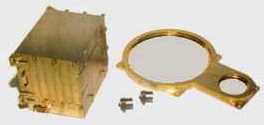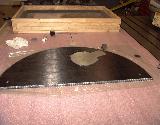| |
 |
| |
Dust Flux Monitor Instrument |
Dust Flux Monitor InstrumentThe Dust Flux Monitor
Subsystem includes a dedicated, sophisticated Dust
Flux Monitor Instrument (DFMI) for small particles,
and two separate acoustic impact sensors that monitor
for strikes by the relatively rare, but especially
dangerous larger particles.
The Dust Monitoring System has four basic goals:
+ To monitor the dust environment
for spacecraft health and interpretation of any
spacecraft anomaly.
+ To provide real-time flux measurements of large
comet dust particles, for early determination
of the potential hazards when the spacecraft begins
to experience the coma environment.
+ To measure the spatial and temporal variations
of particle flux and mass distribution during
the Stardust flyby of Comet P/Wild-2. The DFMI
measurements will provide cumulative and differential
fluxes over the particle mass range 1 x 10-11g
to 2 x 10-4g, as well as cumulative flux for particles
with mass >2 x 10-4 g.
+ To provide the context for the collected dust
samples. Developed under the direction of Tony
Tuzzalino at the University of Chicago, the DFMI
is a highly sensitive instrument designed to detect
particles as small as a few microns. It is based
on a special polarized plastic (PVDF) that generates
electrical pulses when struck by small high speed
particles.
 |
|
Dust Flux Monitor Test Panel
|
|
The DFMI was built on the advances made from
dustinstruments and sensors that have flown on
previous missions. These instruments make exclusive
use of the polyvinylidene fluoride (PVDF) dust
sensor developed in the laboratory of Professor
John Simpson at the University of Chicago, which
include:
+ The Dust Counter and
Mass Analyzer (DUCMA) instruments successfully
flown on the Vega missions to Comet Halley.
+ The ERIS Observer instrument (developed by Lockheed)
which utilized PVDF dust sensors provided by the
University of Chicago. Excellent data was obtained
but remains classified.
+ The Space Dust (SPADUS) instrument for the Advanced
Research and Global Observation Satellite (ATGOS)
to be launched December 1998 (Earth orbiter).
+ The High Rate Detector (HRD) on the Cassini
mission to Saturn (launched October 15, 1997).
DFMI consists of a Sensor Unit (SU), Electronics
Box (EB), and the two acoustic sensors mounted
to the Stardust spacecraft. The SU is mounted
on the Whipple shield, and the EB is mounted internally
to the spacecraft enclosure.
The SU consists of two independent PVDF dust particle
sensors mounted in a frame. Each sensor will be
connected to the EB by a cable with a length of
about four feet (1.4 meter). The combined eight
mass thresholds of these sensors provide cumulative
and differential particle fluxes over the particle
mass range.
The acoustic sensors are in two different locations.
Each device is a quartz piezoelectric transducer
that converts any vibrations in the shield it
is monitoring into electrical signals that are
relayed to the DFMI. The first sensor is mounted
to the first Whipple shield. The second is mounted
to a special acoustic plate, consisting of a thin,
stiff graphite-fiber epoxy sheet sewn to the first
Nextel blanket. It has been shown, by testing
in the laboratory of J.A.M. McDonnell (University
of Kent, Canterbury, England) that particles of
about 1-mm and larger will penetrate the bumper
shield to produce a signal in this detector.
Dust Monitors On Other
Spacecraft
Similar instruments to the Dust Flux Monitor Instrument
(DFMI) developed by the University of Chicago
have flown on other missions, including the former
Soviet Union's Vega missions to Comet Halley in
1986, the ERIS Observer instrument; the Space
Dust (SPADUS) instrument for the Advanced Research
and Global Observation Satellite (ATGOS) in Earth
orbit, and the High Rate Detector (HRD) on the
Cassini mission to Saturn launched in 1997.
The Cassini instrument will study the mass distribution
of particle fluxes during a four-year orbital
tour of Saturn's ring system and conduct measurements
during the Jupiter flyby. A similar instrument
is being considered for other NASA missions.
These instruments make exclusive use of the polyvinylidene
fluoride (PVDF) dust sensor developed at University
of Chicago's Laboratory for Astrophysics and Space
Research of the Enrico Fermi Institute. Professor
John Simpson and Dr. Anthony Tuzzolino, Stardust's
Principle Investigator for the DFMI, have spent
almost two decades focused on developing instruments
for dust particle measurement in space. Dr. Tuzzolino,a
Senior Scientist at the laboratory, is also Co-Investigator
for the Cassini Mission's Cosmic Dust Analyzer.
| Last updated
November 26, 2003 |
|
